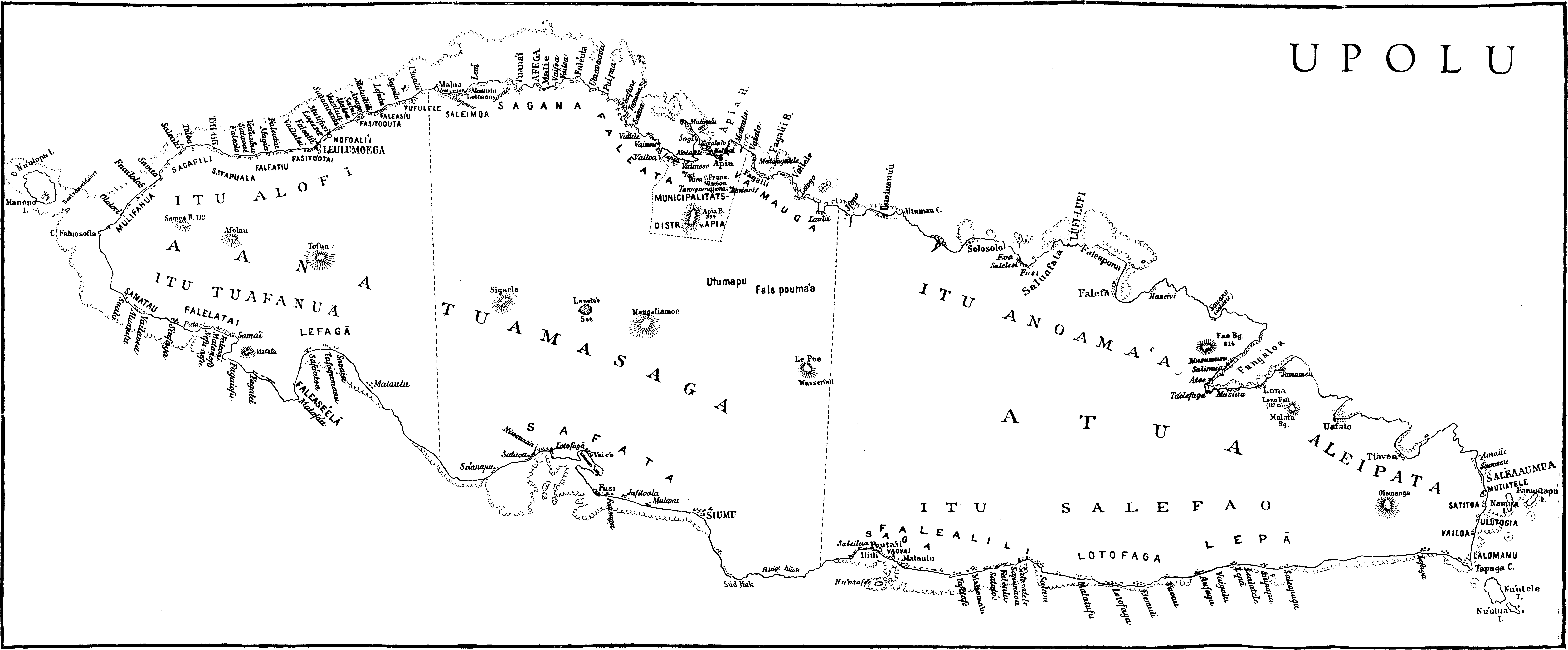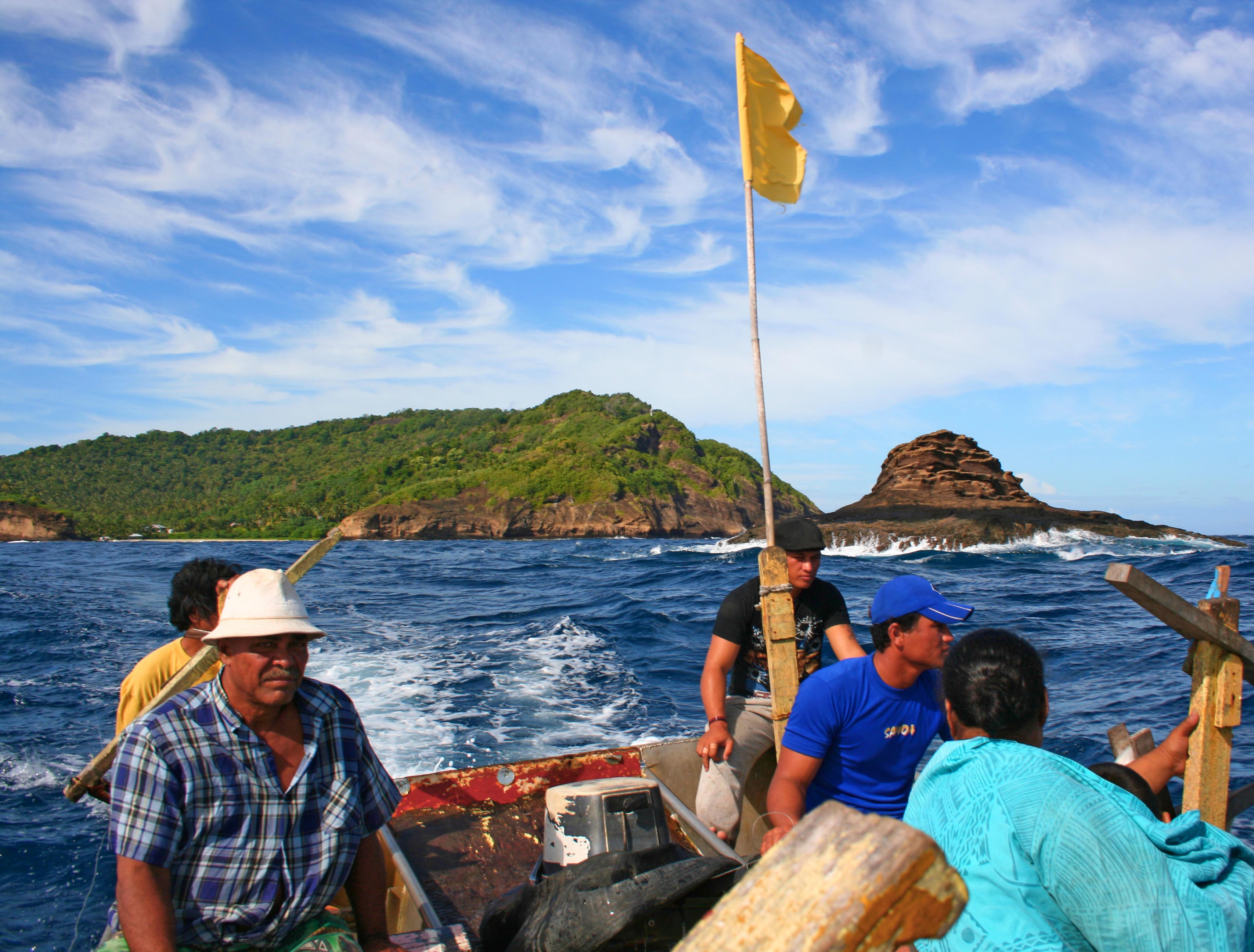|
Faʻasaleleaga
Faasaleleaga is a district of Samoa situated on the eastern side of Savaii island. It has a population of 13,566 (2016 Census). The traditional capital is Safotulafai where district chiefs and orators meet at Fuifatu malae. Safotulafai was the main base of the 'Mau a Pule' resistance movement against colonial rule, International Dictionary of Historic Places: Asia and Oceania by Trudy Ring, Robert M. Salkin, Paul E Schellinger, Sharon La Boda, p. 726 which grew into the national and eventually Samoa's political independence in 1962. Safotulafai also has close traditional links with |
Tuamasaga
Tuamāsaga is a district of Samoa, with a population (2016 census) of 95,907. This makes it the most populous district in Samoa. The geographic area of Tuamasaga covers the central part of Upolu island, and includes the capital, Apia. History and politics Malie & the Malietoa The paramount '' matai'' title of Tuamasaga is the Malietoa title. Led by Auimatagi, Sa Malietoa and the nine senior orators of Malie are responsible for the election of the Malietoa titleholder at Niuʻula in Malie. Given that the district of Aiga-i-le-Tai ( Manono and Apolima) and the district of Faʻasaleleaga on Savaiʻi are two key footholds of the Aiga Sa Malietoa (Malietoa clan), Malie often consults with Manono (capital of Aiga-i-le-Tai) and Safotulafai (capital of Faʻasaleleaga) in the election of the Malietoa. The village of Malie is the seat of the Malietoa. At a national level, the Malietoa title is one of the four ''Tama-a-Aiga'' (noble families) titles. Apia Apia () is the Cap ... [...More Info...] [...Related Items...] OR: [Wikipedia] [Google] [Baidu] |
Districts Of Samoa
Samoa is divided into eleven ''itūmālō'' (political districts), which were established well before the arrival of Europeans. Each district has its own constitutional foundation (''faavae''), rooted in the traditional order of title precedence as outlined in its ''faalupega'' (traditional salutations). The capital village of each district administers and coordinates the district's affairs and confers its paramount title, among other responsibilities. Examples of district governance Aʻana's capital is Leulumoega. The paramount title of Aʻana is the Tui Aʻana, which is conferred by the orator group known as the ''Faleiva'' (House of Nine), based in Leulumoega. The paramount ''tama-a-‘āiga'' title of Aʻana is Tuimalealiifano, held in Falelatai. Currently, there is no holder of the Tui A'ana title, as the orator polity of Leulumoega has yet to make a decision. In Tuamasaga, the paramount ''matai'' title of Malietoa is conferred by the Sa Malietoa of Malie. The ''pā ... [...More Info...] [...Related Items...] OR: [Wikipedia] [Google] [Baidu] |
Samoa
Samoa, officially the Independent State of Samoa and known until 1997 as Western Samoa, is an island country in Polynesia, part of Oceania, in the South Pacific Ocean. It consists of two main islands (Savai'i and Upolu), two smaller, inhabited islands (Manono Island, Manono and Apolima), and several smaller, uninhabited islands, including the Aleipata Islands (Nuʻutele, Nuʻulua, Fanuatapu and Namua). Samoa is located west of American Samoa, northeast of Tonga, northeast of Fiji, east of Wallis and Futuna, southeast of Tuvalu, south of Tokelau, southwest of Hawaii, and northwest of Niue. The capital and largest city is Apia. The Lapita culture, Lapita people discovered and settled the Samoan Islands around 3,500 years ago. They developed a Samoan language and Culture of Samoa, Samoan cultural identity. Samoa is a Unitary state, unitary Parliamentary system, parliamentary democracy with 11 Districts of Samoa, administrative divisions. It is a sovereign state and a membe ... [...More Info...] [...Related Items...] OR: [Wikipedia] [Google] [Baidu] |
Apolima
Apolima is the smallest of the four inhabited islands of Samoa, in central South Pacific Ocean. It lies in the Apolima Strait, between the country's two largest islands: Upolu to the east, and Savai'i to the west. The island has one village settlement, Apolima Tai, with a population of 96. The small settlement is situated in the interior's flat plateau, on the northern side. Apolima is the rim of an extinct volcanic crater with a maximum height of 165 m. Its area is slightly less than one square kilometer. The only access to the island is by boat. The tiny island lies northwest off the westernmost edge of Upolu Island's fringing reef and southwest of the island of Savai'i. The island's shape is like an upturned bowl surrounded by steep cliffs. There is a broad opening to the sea on the northern side, which is the main entry point. Entry is only by boat. There are two neighbouring islands in the strait, Manono Island, which has a small population, and the smaller, uninhab ... [...More Info...] [...Related Items...] OR: [Wikipedia] [Google] [Baidu] |
List Of Schools In Savai'i
A list is a set of discrete items of information collected and set forth in some format for utility, entertainment, or other purposes. A list may be memorialized in any number of ways, including existing only in the mind of the list-maker, but lists are frequently written down on paper, or maintained electronically. Lists are "most frequently a tool", and "one does not ''read'' but only ''uses'' a list: one looks up the relevant information in it, but usually does not need to deal with it as a whole".Lucie Doležalová,The Potential and Limitations of Studying Lists, in Lucie Doležalová, ed., ''The Charm of a List: From the Sumerians to Computerised Data Processing'' (2009). Purpose It has been observed that, with a few exceptions, "the scholarship on lists remains fragmented". David Wallechinsky, a co-author of ''The Book of Lists'', described the attraction of lists as being "because we live in an era of overstimulation, especially in terms of information, and lists help us ... [...More Info...] [...Related Items...] OR: [Wikipedia] [Google] [Baidu] |
Tuasivi
Tuasivi is a village on the north east coast of Savai'i island in Samoa. The village is in the electoral district of Fa'asaleleaga and has a population of 193. Tuasivi is the main centre for government administration on Savai'i. There is a small government complex with offices in the village including a judicial court house and the main police station on the island. Tuasivi Hospital (formally Malietoa Tanumafili II Hospital) is also the main public hospital on the island with about 20 beds and several doctors. It is situated on the coast side of the main road. Tuasivi has a post office and is 10 minutes north of Salelologa Salelologa () is a village district at the east end of Savai'i island in Samoa. It is the main entry point into the island with the only ferry terminal on Savai'i. It also serves as the main township for shopping and public amenities with a marke ... township and ferry terminal. There is also a college and churches of Christian denominations. Referenc ... [...More Info...] [...Related Items...] OR: [Wikipedia] [Google] [Baidu] |
Maota Airport
Maota Airport is the main domestic airport on the island of Savai'i in Samoa. It is situated near Salelologa at the east end of Savai'i. The airport is located 10 minutes south of Salelologa township and ferry terminal. The airport has been in operation since the early 1990s. It was tar-sealed in 1994, and declared a customs port of entry in 1997. In the past, the airport has served flights from Faleolo International Airport on the main island Upolu and Asau Airport at the northwest end of Savai'i, but domestic flights were discontinued before 2000. The airport was refurbished in late 2020, and Samoa Airways resumed domestic flights in September that year. Facilities The airport has a short runway In aviation, a runway is an elongated, rectangular surface designed for the landing and takeoff of an aircraft. Runways may be a human-made surface (often asphalt concrete, asphalt, concrete, or a mixture of both) or a natural surface (sod, ... suitable for Twin Otter and ot ... [...More Info...] [...Related Items...] OR: [Wikipedia] [Google] [Baidu] |
Mulifanua
Mulifanua is a village on the north-western tip of the island of Upolu, in Samoa. In the modern era, it is the capital of Aiga-i-le-Tai district. Mulifanua wharf is the main ferry terminal for inter-island vehicle and passenger travel across the Apolima Strait between Upolu and the island of Savai'i. Ferry terminal The ferry terminal at Mulifanua wharf is five minutes west of Faleolo International Airport. The government's Samoa Shipping Corporation operates the ferry service, seven days a week, between Mulifanua and Salelologa at the east end of Savai'i island. A one-way trip between the two islands takes about 90 minutes. The ferry usually runs every two hours during the day. There are several small shops selling snacks, and there are always buses and taxis available at the terminal for departures and arrivals. Archaeology In 1973, archaeology in Samoa uncovered a Lapita site at Mulifanua where 4,288 pottery sherds and two Lapita type adzes have been recovered. The site ... [...More Info...] [...Related Items...] OR: [Wikipedia] [Google] [Baidu] |
Salelologa
Salelologa () is a village district at the east end of Savai'i island in Samoa. It is the main entry point into the island with the only ferry terminal on Savai'i. It also serves as the main township for shopping and public amenities with a market selling fresh produce and arts and crafts. Salelologa is made up of smaller sub-villages ''pito nu'u'' and falls within the electoral district of Fa'asaleleaga. Township The township consists of one main shopping street. Fresh fish, locally grown produce and arts and crafts are sold at the Salelologa Market (''makeki'') which was recently moved to a new site by the wharf in 2009. The market is open six days a week, Monday to Saturday. Most shops and markets in Samoa close on Sundays with a few small outlets opening in the late afternoon. There are also several small supermarkets, a wholesaler, petrol stations, bakeries such as Retzlaff's bakery, budget hotels and accommodation, as well as public amenities such as internet access, banks ... [...More Info...] [...Related Items...] OR: [Wikipedia] [Google] [Baidu] |
Christianity
Christianity is an Abrahamic monotheistic religion, which states that Jesus in Christianity, Jesus is the Son of God (Christianity), Son of God and Resurrection of Jesus, rose from the dead after his Crucifixion of Jesus, crucifixion, whose coming as the Messiah#Christianity, messiah (Christ (title), Christ) was Old Testament messianic prophecies quoted in the New Testament, prophesied in the Old Testament and chronicled in the New Testament. It is the Major religious groups, world's largest and most widespread religion with over 2.3 billion followers, comprising around 28.8% of the world population. Its adherents, known as Christians, are estimated to make up a majority of the population in Christianity by country, 157 countries and territories. Christianity remains Christian culture, culturally diverse in its Western Christianity, Western and Eastern Christianity, Eastern branches, and doctrinally diverse concerning Justification (theology), justification and the natur ... [...More Info...] [...Related Items...] OR: [Wikipedia] [Google] [Baidu] |
John Williams (missionary)
John Williams (29 June 1796 – 20 November 1839) was an English missionary, active in the South Pacific. Early life He was born in Tottenham, near London, to Welsh parents. In 1810 the family moved to north London and there he served as a clerk to an iron foundry. He also took some interest in smithing. There, his employer's wife first took him to church, and he was immediately drawn to this by a sermon, and the pastor, Reverend Matthew Wilks, enrolled him in a class to prepare for the ministry. However, his heart quickly became set on missionary work. In September 1816, the London Missionary Society (LMS) commissioned him as a missionary in a service held at Surrey Chapel, London. South Pacific missionary On 17 November 1816, John Williams and his wife, Mary Chawner Williams, set sail from London to voyage to the Society Islands, a group of islands that included Tahiti, accompanied by William Ellis and his wife. Travelling via Sydney in Australia they initially only rea ... [...More Info...] [...Related Items...] OR: [Wikipedia] [Google] [Baidu] |





